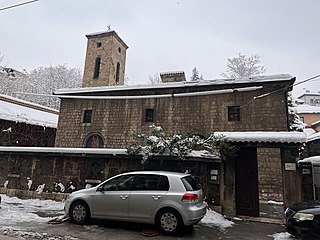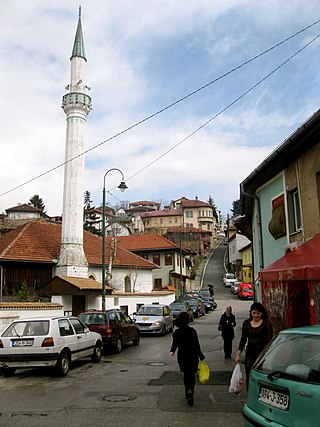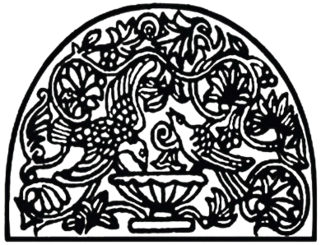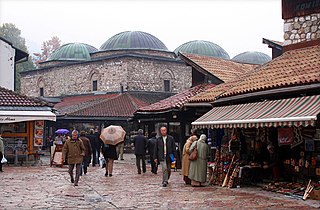
The Herzegovina-Neretva Canton is one of 10 cantons of the Federation of Bosnia and Herzegovina in Bosnia and Herzegovina.

Novo Sarajevo is a municipality of the city of Sarajevo, Bosnia and Herzegovina.

The Sarajevo Haggadah is an illuminated manuscript that contains the illustrated traditional text of the Passover Haggadah which accompanies the Passover Seder. It belongs to a group of Spanish-Provençal Sephardic Haggadahs, originating "somewhere in northern Spain", most likely the city of Barcelona, around 1350, and is one of the oldest of its kind in the world.

Baščaršija is Sarajevo's old bazaar and the historical and cultural center of the city. Baščaršija was built in the 15th century when Isa-Beg Ishaković founded the city.

The National Museum of Bosnia and Herzegovina is located in central Sarajevo, the capital of Bosnia and Herzegovina.

The Church of the Holy Archangels Michael and Gabriel, also known as the Old Orthodox Church, is a Serbian Orthodox church in Sarajevo, Bosnia and Herzegovina. It was established in 1539. It was, however, built on older foundations.

Franciscan Province of Bosna Srebrena is a province of the Franciscan order of the Catholic Church in Bosnia and Herzegovina, historically active in Croatia as well. Their headquarters are currently in Sarajevo.

Sarajevo City Hall, known as Vijećnica, is located in the city of Sarajevo, Bosnia and Herzegovina. It was designed in 1891 by the Czech architect Karel Pařík, but criticisms by the minister, Baron Béni Kállay, caused him to stop working on the project. It was initially the largest and most representative building of the Austro-Hungarian period in Sarajevo and served as the city hall.

Despić House is an old merchant house in Sarajevo, Bosnia and Herzegovina that was established in 1881 by one of the wealthiest and most prominent Serb families in Sarajevo. It is a branch of the Museum of Sarajevo.
Bijeljani is a village in the municipality of Bileća, Republika Srpska, Bosnia and Herzegovina. According to the 1991 census the village had a population of 138 people. A monastery was once located in Bijeljani, Dabarsko polje, Stolac. There is also a mosque in the village.
Gazije is a village in the Republika Srpska, Bosnia and Herzegovina. According to the 1991 census, the village is located in the municipality of Rogatica.
Guždelji is a village in the Republika Srpska, Bosnia and Herzegovina. According to the 1991 census, the village is located in the municipality of Rogatica.

The Miloradović or later Stjepanović (Стјепановић), whose paternal parent house was Hrabren (Храбрен), were an Eastern Orthodox Bosnian Vlach noble family and a katun clan from Hum, and later Sanjak of Herzegovina, parts of present-day Bosnia and Herzegovina, and whose some later branches embraced the Bosnian Serb ethnic identity, while others converted to Islam and became Bosnian Muslims. The members of the family served the Kingdom of Bosnia, the Republic of Ragusa, and the Ottoman Empire. One branch of the Miloradović's established themselves as military leaders of Russian Empire and were adopted into the Russian nobility. The family left behind several cultural-historical monuments important to Bosnian and Herzegovinian heritage, protected as such by the KONS state agency and the UNESCO.

The Vekil-Harrach or Hadžijska mosque is a mosque in the city of Sarajevo, Bosnia and Herzegovina. It is located in Alifakovac, a neighborhood in Babića bašća local community, one of the oldest urban settlements in Sarajevo.

The War Childhood Museum is a historical museum in Sarajevo, Bosnia-Herzegovina that opened in January 2017. The museum presents the experiences of children who lived through the war in Bosnia, told through objects, video testimonies, and excerpts from oral histories. The 2018 Council of Europe Museum Prize, one of the most prestigious awards in the museum industry, was awarded to the War Childhood Museum as part of the 2018 European Museum of the Year Award.

Sarači street is one of main pedestrian streets in Sarajevo, located in Baščaršija, Stari Grad Municipality. Sarači street is named after Saraç, a Turkish word for craftsmen who are making saddles.
Walter Tausch was a 20th-century Austrian photojournalist, based in Sarajevo, who recorded the last images of Archduke Franz Ferdinand of Austria and his wife minutes before their assassination 28 June 1914, and documented the arrest of a suspect in Sarajevo, erroneously believed to be assassin Gavrilo Princip. Tausch's photographs were sold and published around the world, contributing to public shock and outrage. Walter Tausch's images are part of the History Museum of Bosnia and Herzegovina's permanent photography collection.

Museum of Literature and Theater Arts of Bosnia and Herzegovina is a literary art museum in Sarajevo, Bosnia and Herzegovina. It was established under the name Museum of Literature of Bosnia and Herzegovina in 1961 on the idea of then curator of literary collections in the Museum of Sarajevo, writer Razija Handžić, the future director. In 1970, the Theater Department was founded and added to the Museum of Literature.

Brusa bezistan with its 6 roof domes it is one of the historic buildings in Sarajevo's Baščaršija from the time of the Ottoman period in the history of Bosnia and Herzegovina. It has a rectangular base and has four entrances on all four sides, and connects the craft streets Kundurdžiluk, Veliki and Mali Čurčiluk with Abadžiluk and the Baščaršija. It was built by order of the Grand Vizier Rustem-pasha Opuković in 1551. Bezistan was named after the Turkish city of Bursa, from which silk was brought to Bezistan and sold. Unlike Gazi Husrev-beg's bezistan, where groceries were originally sold, Brusa bezistan sold household items and small furniture in addition to silk. Today it is one of the museums in the city, designated as the National monument of Bosnia and Herzegovina by the Commission to preserve national monuments of Bosnia and Herzegovina, and houses one of the departments of Museum of Sarajevo.

Nada Miletić was a Bosnian medievalist, art historian and archaeologist, who was a scientific expert at the National Museum of Bosnia and Herzegovina and founded the study of the Migration Period in Bosnian archaeology.


















